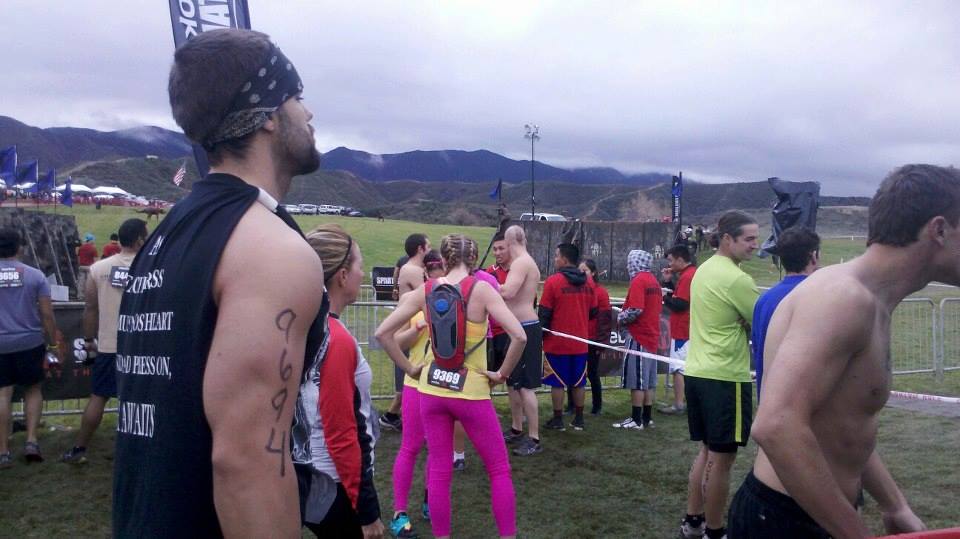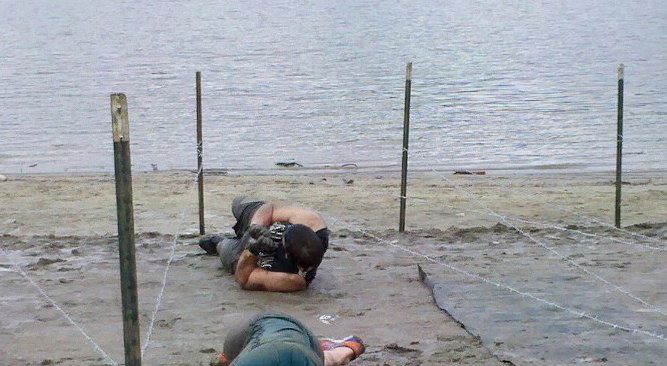Dominating Obstacle Races with Ultimate Sandbag Training
2017-04-12
We got such a huge response from this week’s release of DVRT Master, Ian Vaughn’s, DVRT for Obstacle Course Racing (HERE) that we wanted to delve deeper. With so many self-proclaimed “experts” in internet land, it is almost refreshing to to have a REAL coach with experience and success. Even if you aren’t into Obstacle Course Racing, I know you will get some great information out of this interview!
Q: What got you into obstacle course racing?
IV: When I first saw a online Spartan Race a video I was really intrigued seeing people doing all these crazy obstacles in the videos. I was getting really bored of my workouts and wanted something new. So I signed up for the first one of year in 2013. At the time, no one really knew anything about Obstacle Course Racing. When people asked what I was training for, the response was always “oh that sounds barbaric!”. Which I liked versus doing a typical half/full marathon.

At the starting line at my first 8mile OCR in 2013 at Lake Vail in Temecula,CA
Q: What were you most surprised in actually doing Obstacle Course Racing?
IV: How much fun Obstacle Course Racing was and then the truth I wasn’t as strong as I thought I was. Made me really re-think how to train instead of just always running and doing pointless burpees in my programing. I felt my training did well crawling, rolling, and jumping over obstacles, but the monkey bars, vertical rope climb, and transverse wall really surprised me not having the grip or core strength.

Q: What were the biggest lessons you took from your first experiences?
IV: Anyone experienced in Obstacle Course Racing will tell you NOT TO WEAR COTTON. I felt twice as heavy when wearing just one cotton cutoff shirt because all the mud and water will soak it up quick (get good cleats that can drain fast too).
Mentally, I felt the body is meant for so much more than moving in a machine, treadmill, and using typical weights such as dumbbells. I was currently also applying everywhere in LA County to be a firefighter; so this was a perfect vessel for a tactical athlete to stay in good shape. All the lessons I took from my first 8mile OCR transitioned very well into my second 13mile OCR conquering more obstacles. I ran less, and focused on moving better…it was that simple.
Q: How did that start to change how you prepared and trained people for Obstacle Course Racing?
IV: I started veering away from more machines and focused more on movement. I stopped focusing on movements I already knew my athletes we’re good at and focused more on their weaknesses. A good example was someone who could do burpees all day, but couldn’t bear crawl with a neutral spine. The problems with burpees is people do them with zero tension in right places and they turn into what I call “floopies”.
It’s basically the same when someone kips into a pull-up position with no lats/glutes involved…you look like a noodle. This puts all this unnessary compression and hyperextension in the low back. If you need fully flex your low back and forth under load to contract muscles…you will never understand strength. Here are two videos to demonstrate. How to do a proper burpee and challenging your bear crawl laterally just as would a transverse wall climb in a Obstacle Course Racing event:
Q: How did DVRT play a role in how you began preparing people?
IV: Immediately played a huge roll. The week after I attended the DVRT certification I got called by Spartan Race to coach over 2,000 spartans racers for a Hurricane Heat workout in Temecula, CA. I was scared beyond belief because I’ve never coached this amount people. What was incredible about the cert was Josh made it more about the DVRT coaching style and the Ultimate Sandbag as the primary vehicle. In contrast if you own a fast car, but you’re driving skills suck…the car is worthless. Same goes for your coaching skills and as I got waves and waves of hundreds of athletes coming in at the Spartan Hurricane Workout I tapped into a lot of what Josh taught me about planking, squatting, hinging, pushing/pulling and challenging them in different positions. This resulted in a lot people after coming up to me saying the workout was incredibly challenging…AND FUN. Anyone can scream and bark out orders, but it’s WAY more valuable to coach
Coaching the Spartan Hurricane Workout in 2014

After, and years later now it’s become a huge stable in my training and my athletes. Everyone I train now DOESN’T COME BACK WITH AN INJURY after a Obstacle Course Racing event. Half the OCR athletes that come to me is from word of mouth from another athlete that they never feel wrecked after a workout with me and get stronger. Which translated to not getting wrecked at a OCR.
The Ultimate Sandbag is a extremely dynamic tool for getting hip mobility & stability. I have noticed knee injuries have been extremely common among OCR athletes. Usually the knee ONLY knows sagittal plane movements and has poor range of motion always being flexed (especially from running). The Ultimate Sandbag Side to Side Lunge with a Clean covers a lot of bases getting that lost mobility/stability back into action:
Q: You have a new program for obstacle racing, tell us why this is a unique program?
IV: Yes, very excited about it. Focuses on a lot on we just talked about; which is focusing on moving better, and getting stronger at doing what you have FUN doing because this program prepares you for it. I set up three different baseline tests:
DVRT Clean & Press Test for overall strength when carrying, lifting, pushing/pulling
Hang Test for shoulder stability when climbing and crawling
Uphill Sprint+Burpee Test for cardiovascular endurance
You test yourself beforeonly picking 2 out of 3. The idea is to pick your weakness, not your strength. You’ll do 4 workouts a week; going 2 day on, one rest day in between. At the end of the week you’ll do the two picked tests and see if you’ve gotten any results from using the DVRT Ultimate Sandbag, kettlebell swings , and bodyweight drills so we know if “did it work?”
The workouts are simple, but don’t confuse simple with “easy”. Believe me, I was pretty worked from filming every movement in this program. Which is the other big perk, is seeing every movement demoed by me to with audio coaching cues to help give more precision to this program. The program goes a solid 5 weeks with 18 workouts with 64 movements with a everyday DVRT warmup and cool down flexibility drills.

You can check out Ian’s new program for 25% off with coupon code “stronger” HERE
Q: What if people aren’t going to hit up an obstacle course race any time soon, would the benefit from this program?
IV: Even though the program is aimed at OCR athletes it could be used for someone into other various sports. Remember the body is meant for more than machines and treadmills. If we treat the body as ONE piece, just as we would as sports athlete, marathoner, military, first responder, or OCR this program still teaches this exact point. You’ll be surprised how these movements can get you stronger
Q: Would you encourage people to look into participating in Obstacle Course Racing and how could they start?
IV: First is to just do it and sign up. That way there’s no backing out. I can not tell you how many people I’ve met saying they’re going to sign up and BE ALL TALK (even post on social media to get praise). Actions speak louder than words.
Sign up, do the workouts needed (which my program a greatly help with once again), show up on the date, don’t wear cotton, and HAVE FUN. Its great way to make new friends on the track and they’ll help you over obstacles because everyone has the common goal to be better version of themselves by supporting others. What really drives OCR is the community. It gives a new found purpose that you can do more in life than you thought you could and sometimes complete strangers make you realize that as crazy it sounds. It’s a great time at the end of the day, and one I hope you’ll get to experience one day.
© 2025 Ultimate Sandbag Training. Site by Jennifer Web Design.







